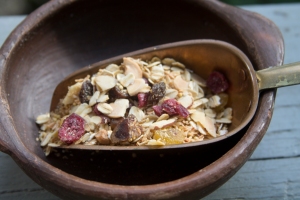A healthy diet can reduce the risk of major chronic illnesses, such as heart disease, diabetes, osteoporosis, and some cancers. We have all heard this before, and yet the question I hear most frequently as a personal trainer is: What do I eat?
Here’s my advice!
1. Eat fresh, unprocessed food:
Highly processed foods are those that come in packages and have a really long list of ingredients, many of which will be hard to pronounce. When purchasing packaged food, make sure that you carefully read the labels. Unfortunately, almost half of the processed foods that claim to be “natural,” “low in fat,” “a good source of calcium,” or “made with whole grains,” are high in saturated fat, added sugars and/or sodium.
According to the 2010 Dietary Guidelines, daily sodium intake should be less than 2,300 mg, calories from saturated fatty acids should be less than 10%, and total daily amount of dietary cholesterol should stay below 300 mg. The guidelines also recommend limiting the amount of calories that come from added sugars and solid fats, restricting consumption of trans fatty acids, and reducing consumption of foods that contain refined grains. All this can be easily achieved by eating fresh, unprocessed foods.
 2. Eat all types of vegetables and fruits:
2. Eat all types of vegetables and fruits:
If you broaden your range of fresh produce, you will not only increase your intake of nutrients such as folate, magnesium, potassium, dietary fiber, and vitamins, but you’ll add variety to your diet and have more cooking options. Some vegetables and fruits have been linked to reduced risk of certain cancers. In a recent study, scientists found that the increment of as little as 100g of fruits and veggies a day (roughly one large orange) was associated with a reduced risk of lung cancer.
A great way to incorporate more fresh produce into your diet is to visit your local farmers market, or, if there is one in your area, join a Community Supported Agriculture group (CSA, http://www.localharvest.org/csa/). Either will provide you with access to local, seasonal food directly from the producers.

Grains (from left to right): brown rice, lentils, quinoa, flax seeds (on plate), black eyed beans, adzuki beans
3. Eat whole grains:
What’s wrong with white flour, rice and pasta? They come from whole grains too, right? Yes, they do, but they fall into the category of highly processed foods. This is because in order for whole grains to reach the “white” category, they must go through a milling process that strips them of most vitamins and minerals. Even though manufacturers add some minerals and vitamins back to refined grains, they’re never restored to their original levels. When unprocessed, whole grains are a great source of iron, magnesium, selenium, B vitamins, and dietary fiber: nutrients that are essential for good nutrition.
4. Eat lean proteins:
These include legumes, like beans, peas and lentils, in addition to poultry and meats. Besides being a great source of proteins, legumes contain soluble and insoluble fibers, are low in fat (and the fats they contain are beneficial), free of cholesterol, and high in folate, potassium, iron and magnesium. Tofu, made from soybeans, is another lean protein alternative if you don’t want to eat meat.
As for protein that comes from animal sources: meats contain 2-3 g of fat and 55 calories per serving, according to the National Heart Lung and Blood Institute. That is, about 1 oz. of either skinless chicken or turkey, salmon, or lean beef. The fat in beef and the skin on poultry may be what makes them tasty, but it’s also make them unhealthy. However, you don’t have to settle for dry, flavorless meats. Using herbs, spices, and low sodium broth you will be able to enjoy great-tasting meat that is also good for your body.

Some great cooking spices (turmeric, clove, black pepper, cinnamon, sweet paprika, anise star, cardamom), herbs (oregano), and nuts (cashews and walnuts)
5. Eat healthy fats:
Despite what you may have heard, we all need fat in our diets! Healthy fat, that is. Without fats, our cells would have defective membranes, we couldn’t process essential vitamins such as Vitamin A, and without thermal protection and cushioning for our internal organs, we couldn’t control our body temperatures or engage in most forms of physical activity.
So which fats are the “healthy” ones? In general, vegetable oils contain polyunsaturated and/or monosaturated fat, both of which are desired in a healthy diet. However, some vegetable oils, including coconut and palm oil, contain saturated fats and should be avoided. The two best types of vegetable oil commonly found in US stores are canola oil and olive oil. Most saturated fats and trans-fatty acids, present in butter and lard, are solid at room temperature and have been linked to cardiovascular disease. These fats should be avoided
whenever possible. Make sure you read the labels on the foods you buy; if you see the word hydrogenated in the ingredients or if the amount of saturated fat per serving is 20% of the daily value (DV) or higher, then it’s wise to find an alternative.
Another good source of healthy fats, as well as protein, are nuts and seeds. Consumption of nuts is associated with a lower risk of heart disease and diabetes. Additionally, some nuts and seeds, such as almonds and sunflower seeds, are high in Vitamin E. Nuts and seeds may be packed with nutrients, but they are also high in calories, so they should be consumed in limited portions. They make a great mid-morning/afternoon snack or a tasty addition to salads and vegetable dishes (just make sure that you buy the raw kind to avoid extra oils and or salt).
Eating healthy will make you feel better, mentally & physically!
If you fill up on highly processed foods, you will always be hungry, even if you are overweight, because what you’re missing are essential nutrients. Below are two of the recipes I use to incorporate whole grains, fruits, veggies, nuts and seeds, and vegetable oil in my diet. Your meals don’t have to be flavorless to constitute a healthy diet. If you’re used to eating processed foods, you might have to retrain your taste buds a bit to appreciate simple flavors, but fortunately, this doesn’t take long. As you move away from refined, packaged foods, you will learn to taste the “real” flavors in fresh ingredients and feel satisfied with fewer calories.
Recipes
1. Overnight Oatmeal (adapted from Alton Brown’s recipe)
You need a slow cooker for this recipe, but the beauty of it is that you’ll have a warm bowl of delicious breakfast cereal waiting for you as soon as you get up in the morning!
Ingredients (4-5 servings):
1 cup steel cut oatmeal
4 cups water (or rice milk)
1 1/2 cups dried fruits, nuts, and seeds mix (match to your taste, e.g., raisins, dates, dried figs, cranberries*, dried cherries, walnuts, cashews, pecans, crushed** flax seeds, sunflower seeds, etc.)
Directions:
Mix everything in the slow cooker at night before you go to sleep (8 hours at least), set it on low, and get ready for a delicious breakfast first thing in the morning! You can add a tablespoon or two of low fat or fat free yogurt to your meal I like to have this kind of breakfast when I know I will have a long morning, because it keeps me full for hours.
* These have added sugar, so be careful about how many you use.
** Buy the flax seeds whole and crush only the amount you will use; the oil that is released when the seeds are crushed loses its nutrients quickly.
2. Shiitake Mushrooms Risotto
Ingredients:
150g shiitake mushrooms, clean
1 1/2 cups of brown rice, any kind (short grain is better, but what ever you have will do)
1 1/2 tsp. low sodium vegetable broth (or 1/2 cube of regular sodium vegetable broth)
2 1/2 cups water
Directions:
Place all the ingredients in a slow cooker set to low and cook for 4-5 hours. You can replace the mushrooms with any type of vegetable. If you forgot to set up the slow cooker and need prepare dinner in a hurry (under 30 min), you can do a faster version of this recipe using a pressure cooker. Add the same ingredients to the pressure cooker and when the valve goes off, lower the temperature and let it cook for 20 min. When I make the fast version, I usually use butternut or acorn squash instead of mushrooms (the mushroom risotto takes a bit more preparation, and I tend to have squash in the house more often than mushrooms.)













